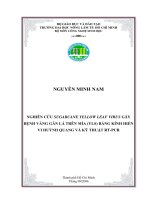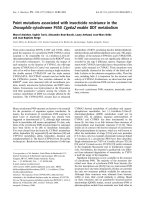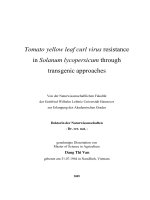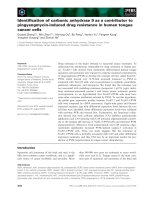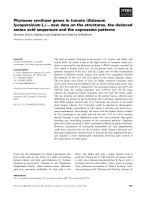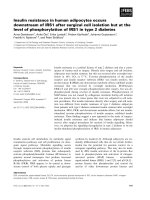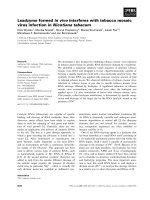tomato yellow leaf curl virus resistance in solanum lycopersicum through transgenic approaches
Bạn đang xem bản rút gọn của tài liệu. Xem và tải ngay bản đầy đủ của tài liệu tại đây (2.84 MB, 154 trang )
Tomato yellow leaf curl virus resistance
in Solanum lycopersicum through
transgenic approaches
Von der Naturwissenschaftlichen Fakultät
der Gottfried Wilhelm Leibniz Universität Hannover
zur Erlangung des Akademischen Grades
Doktorin der Naturwissenschaften
- Dr. rer. nat. -
genehmigte Dissertation von
Master of Science in Agriculture
Dang Thi Van
geboren am 31.07.1964 in NamDinh, Vietnam
2009
Referent: Prof. Dr. Hans-Jörg Jacobsen
Korreferent: Prof. Edgar Maiß
Tag der Promotion: 07.12.2009
ABSTRACT I
ABSTRACT
Tomato yellow leaf curl virus (TYLCV), belonging to the Geminiviridae (Genus:
Begomovirus), constitutes a serious constraint to tomato production worldwide and leads,
especially in the tropics and subtropics, to large economical losses. Resistant tomato
varieties are powerful tool to control TYLCV disease. However, nearly all commercially
available tomato varieties are susceptible to TYLCV and resistance genes are mainly
present in wild type tomato. Genetic engineering can provide a potential solution for the
introduction of beneficial traits including virus resistance. This study was conducted to
develop a transformation system for Solanum lycopersicum to create transgenic tomato
plants resistant to TYLCV via a gene silencing (RNA interference, RNAi) approach.
The study focused first on optimization of a transformation protocol using Agrobacterium
tumefaciens EHA105 harbouring the helper plasmid pSoup and pGreenII as a vector for
the delivery of genes into expanding leaves of different commercial tomato cultivars from
Vietnam. As an efficient transformation system depends on both an efficient regeneration
system as well as an efficient method for the introduction of foreign genes into the plant
cells, optimization of media and conditions for shoot regeneration from expanding leaves
of four tomato cultivars was performed using glucuronidase (gus) as a marker gene. The
experiments showed phytohormones (trans-zeatin and indolacetic acid) have an effect to
induce competent cells for transformation. Supplement of trans-zeatin in combination with
indolacetic acid into pre-treatment, inoculation, as well as co-culture media resulted in a
higher frequency of transformation and a stronger gus expression. As a wide variety of
inoculation and co-culture conditions have been shown to be important for the
transformation, the results of the study showed that the temperature during the inoculation
and co-culture as well as the concentration of A. tumefaciens had the highest influence on
the transformation efficiency. In addition, the experiments also showed that Agrobacterium
inoculation was an additional stress to the explants, resulting in a more sophisticated
glufosinate selection scheme, leading to an optimized protocol for tomato transformation
using pSoup / pGreenII.
Two inverted-repeat transgenes derived from different regions of Tomato yellow leaf curl
Thailand virus (TYLCTHV) DNA-A were used to transform and regenerate Solanum
ABSTRACT II
lycopersicum var. FM372C plants that can trigger RNAi to induce TYLCV resistance. The
first construct derived from the intergenic region included a part of the gene coding for the
replication-associated protein (IR/Rep), while the second construct incorporated parts of
the pre-coat protein and coat protein (Pre/Cp). The independent transgenic (To) plants
were screened for the presence of the transgenes by PCR and Southern blot analyses. The
T
1
transgenic plants in the 5-7 leaf stage were verified by PCR for IR/Rep and Pre/Cp,
respectively, before agroinoculation either with TYLCTHV DNA-A and DNA-B or
Tomato yellow leaf curl Vietnam virus (TYLCVV). The disease development was recorded
and presence of the viruses was determined by PCR and ELISA. Early symptoms, like
yellowing and curling of leaves in non-transgenic and susceptible transformed plants
occurred 3 weeks after inoculation and progressed into severe symptoms, characteristic of
TYLCV disease, in the following weeks. Resistance to TYLCV was ranged form
tolerance, typical in several Pre/CP transgenic lines to immunity of one IR/Rep transgenic
line. In addition, IR/Rep transgenic plants were able to resist TYLCTHV as well as
TYLCVV, while Pre/CP transgenic plants were only tolerant to the cognate virus, the
TYLCTHV. The results of the study indicate that inverted repeat constructs are able to
confer resistance to geminiviruses.
Keywords: Transformation, Solanum lycopersicum, TYLCV, RNAi, resistance.
ZUSAMMENFASSUNG III
Zusammenfassung
Das Tomato yellow leaf curl virus (TYLCV), Familie Geminiviridae (Gattung:
Begomovirus), stellt weltweit, vor allem aber in den Tropen und Subtropen, ein ernsthaftes
Problem in der Tomatenproduktion dar, wobei es erhebliche wirtschaftliche Verluste
verursachen kann. Eine Möglichkeit, um TYLCV wirkungsvoll zu bekämpfen, stellen
resistente Tomatensorten dar. Fast alle im Handel erhältlichen Tomatensorten sind jedoch
anfällig für TYLCV und Resistenzgene für Züchtungsprogramme finden sich
hauptsächlich in Wildtyp-Tomaten. Gentechnische Ansätze könnten eine mögliche Lösung
für die Etablierung von Resistenzen gegenüber Viren liefern. Diese Arbeit hatte zum Ziel
ein Transformationssystem für Solanum lycopersicum zu optimieren, um damit transgene
Tomatenpflanzen mit einer Resistenz gegen TYLCV über ein Gen-Silencing-Konzept
(RNA-Interferenz, RNAi) zu entwickeln.
Die Arbeiten konzentrierten sich zunächst auf die Optimierung des
Transformationsprotokolls von Blattmaterial verschiedener kommerzieller Tomatensorten
aus Vietnam unter Verwendung von Agrobacterium tumefaciens EHA105 mit dem
Helferplasmid pSoup und pGreenII als Vektor für das zu transformierende Gen. Ein
effizientes System zur Transformation hängt von der effektiven Regeneration und einer
effektiven Methode für die Einführung fremder Gene in die Pflanzenzellen ab. Die
Optimierung der Nährmedien und der Bedingungen für die Regeneration von vier
Tomatensorten erfolgte mit Glucuronidase (gus) als Markergen. Die Versuche zeigten,
dass Phytohormone (trans-Zeatin und Indolylessigsäure; IAA) einen Effekt auf die
Kompetenz der Zellen für die Transformation ausübten. Die Zugabe von trans-Zeatin und
IAA in die Vorkulturmedien, während der Inokulationsphase und in die Co-Kultur Medien
führte zu einer höheren Transformationsfrequenz und eine stärkeren GUS-Expression. Auf
die Transformation hatten die Temperatur während der Inokulation und der Co-Kultur
sowie die Konzentration von A. tumefaciens die stärksten Einflüsse. Darüber hinaus
zeigten die Versuche auch, dass die Agrobacterium-Inokulation eine zusätzliche Belastung
für die Regeneration der Explantate darstellte, so dass eine Verbesserung der Glufosinat-
Selektion nötig wurde, um zu einem optimierten Protokoll für die Tomatentransformation
mittels pSoup / pGreenII zu gelangen.
ZUSAMMENFASSUNG IV
Zwei als inverted-repeat angeordnete Regionen der DNA-A des Tomato yellow leaf curl
Thailand virus (TYLCTHV) wurden zur Transformation und Regeneration von Solanum
lycopersicum var. FM372C verwendet, um RNAi gegen das TYLCV zu erzielen. Das erste
Konstrukt umfasst die sogenannte „Intergenic region“ einschließlich eines Teils des Gens
für das replikationassoziierte Protein (IR/Rep), während das zweite Konstrukt Teile des
Pre-Hüllprotein- und Hüllproteingens (Pre/Cp) enthält. Die unabhängigen transgenen (To)
Pflanzen wurden auf das Vorhandensein des jeweiligen Transgens mittels PCR und
Southern-Blot-Analysen überprüft. Die T1-transgenen Pflanzen wurden im 5-7 Blatt-
Stadium erneut durch PCR auf die Präsenz von IR/ Rep bzw. auf Pre/Cp geprüft, bevor die
Pflanzen entweder mit TYLCTHV DNA-A und DNA-B bzw. mit Tomato yellow leaf curl
Vietnam virus (TYLCVV) agroinokuliert wurden. Die Symptome wurden bonitiert und das
Auftreten der Viren durch PCR und ELISA bestimmt. Frühe Symptome, wie Gelbfärbung
der Blätter und Blattrollen in nicht-transgenen und anfällig reagierenden transformierten
Pflanzen traten 3 Wochen nach Inokulation auf. Mit Fortschreiten der Erkrankung kam es
zu schweren Symptomen, die charakteristisch für die TYLCV Krankheit waren. In
mehreren Pre/Cp transgenen Linien wurde eine Toleranz gegen das TYLCTHV, nicht aber
gegen das TYLCVV gefunden. Eine Linie der IR/Rep transgenen Pflanzen reagierte mit
Immunität auf die Inokulation mit TYLCTHV und TYLCVV. Die Ergebnisse zeigen, dass
mit inverted-repeat Konstrukten Toleranz bzw. Resistenz auch gegen Geminiviren erzielt
werden kann.
Stichworte: Transformation, Solanum lycopersicum, TYLCV, RNAi, Resistenz
TABLE OF CONTENTS V
TABLE OF CONTENTS
ABSTRACT…………………………………………………………………………………I
ZUSAMMENFASSUNG………………………………………………………………….III
TABLE OF CONTENTS………………………………………………………………… V
ABBREVIATIONS……………………………………………………………………… IX
CHAPTER 1
General information
1.1 General introduction……………………………………………………………………1
1.2 Literature review……………………………………………………………………… 5
1.2.1 Tomato yellow leaf curl virus – Taxonomy………………………………………… 5
1.2.2 Begomoviruses-genome structure………………………………………………… 6
1.2.2.1 The intergenic region - promoters and transcription……………………………… 8
1.2.3 Viral proteins……………………………………………………………………… 9
1.2.3.1 The coat protein…………………………………………………………………… 9
1.2.3.2 The precoat protein……………………………………………………………… 10
1.2.3.3 The replication associated protein (REP) …………………………………………10
1.2.3.4 The replication enhancer protein (REn)………………………………………… 11
1.2.3.5 The transcriptional activator protein (TrAP)………………………………………11
1.2.3.6 The AC4/C4 protein……………………………………………………………….12
1.2.3.7 The movement proteins (BC1 and BV1)………………………………………… 12
1.2.3.8 Beta satellites and the βC1 protein……………………………………………… 12
1.2.4 Infection cycle of begomovirus…………………………………………………… 13
1.2.4.1 Begomovirus transmission……………………………………………………… 13
1.2.4.2 Infection cycle in plants………………………………………………………… 14
1.2.5 Resistance breeding through transgenic approaches……………………………… 16
1.2.5.1 Pathogen-derived resistance through the expression of viral proteins…………….17
1.2.5.1.1 REP-mediated resistance……………………………… ……………………….17
1.2.5.1.2 Coat protein-mediated resistance……………………………………………… 18
1.2.5.1.3 Movement protein-mediated resistance…………………………………………19
1.2.5.2 RNA/DNA-mediated resistance………………………………………………… 19
1.2.5.2.1 Post-transcriptional gene silencing (PTGS) ……………………………………19
TABLE OF CONTENTS VI
1.2.5.2.2 Antisense RNA……………….…………………………………………………21
1.2.5.2.3 Defective interfering DNA (DI)………….…………………………………… 22
1.2.5.3 Expression of non-pathogen derived antiviral agents…………………………… 23
1.2.5.3.1 Trans-activation of a toxic protein……… …………………………………….23
1.2.5.3.2 Expression of DNA binding proteins… ……………………………………….23
1.2.5.3.3 A Chaperonin (GroEL) ……………………………………………………… 24
1.2.5.3.4 Peptide aptamers……………………………………………………………… 24
1.2.6 Gene silencing via RNAi…………………………………………………………….25
1.2.7 Tomato transformation………………………………………………………………28
1.3 Aims and significance of the study……………………………………………………31
CHAPTER 2
Development of a simple and effective protocol for leaf disc
transformation of commercial tomato cultivars via Agrobacterium
tumefaciens
2.1 Introduction……………………………………………………………………………33
2.2 Materials and methods……………………………………………………………… 34
2.2.1 Materials…………………………………………………………………………… 34
2.2.2 Method of optimising for shoot regeneration ……………………………………….35
2.2.3 Methods of optimising conditions for transformation……………………………….35
2.2.4 Development of the transformation process…………………………………………36
2.2.5 Experimental design and data analysis………………………………………………37
2.3 Results ……………………………………………………………………………… 37
2.3.1 Optimising shoot induction from leaf explants…………………………………… 37
2.3.2 Effect of Agrobacterium cell density on transformation frequencies……………….38
2.3.3 Effect of temperature during inoculation and co-culture on transformation
frequencies……………………………………………………………………………… 40
2.3.4 Effect of plant phytohormones during inoculation and co-cultivation on
transformation frequencies……………………………………………………………… 41
2.3.5 Determining the critical concentration of glufosinate on callus and root induction 43
2.3.6 Establishment of a full transformation process …………………………………… 46
2.4 Discussion…………………………………………………………………………… 47
TABLE OF CONTENTS VII
CHAPTER 3
The inverted-repeat hairpinRNA derived from intergenic region and Rep
gene of TYLCTHV confers resistance to homologous and heterologous
viruses
3.1 Introduction……………………………………………………………………………54
3.2 Materials and methods……………………………………………………………… 55
3.2.1 Transformation of plants…………………………………………………………….55
3.2.1.1 Bacterial system and vectors………………………………………………………55
3.2.1.2 RNAi constructs (self-complementary hairpin RNA constructs)…………………55
3.2.1.3 Plant transformation procedure and anlayses of transgenic plants……………… 56
3.2.1.4 Plant DNA isolation……………………………………………………………….56
3.2.1.5 Polymerase chain reaction (PCR)………………………………………………….57
3.2.1.6 Southern hybridization…………………………………………………………….58
3.2.2 Evaluation of plants resistance in transgenic plants……………………………… 59
3.2.2.1 Plant material…………………………………………………………………… 59
3.2.2.2 Virus agroinoculation…………………………………………………………… 59
3.2.2.3 Evaluation of virus symptoms…………………………………………………… 60
3.2.2.4 Confirmation of virus presence by PCR………………………………………… 62
3.3 Results…………………………………………………………………………………63
3.3.1 Confirmation of successful transformation via PCR……………………………… 63
3.3.2 Seed production from To plants…………………………………………………… 64
3.3.3 Identification of transgene copy number in transformed plants…………………… 64
3.3.4 TYLCTHV resistance tests in T
1
plants transformed with the IR/Rep-hpRNA
construct………………………………………………………………………………… 68
3.3.4.1 Agroinoculation of Nicotiana benthamiana with TYLCTHV and TYLCVV…….68
3.3.4.2 Agroinoculation of transgenic tomato plants with TYLCTHV……………………69
3.3.4.3 TYLCTHV detection by PCR…………………………………………………… 72
3.3.4.4 Molecular characterization of transgene in immunity plants by Southern
hybridization……………………………………………………………………………….74
3.3.4.5 Agroinoculation of transgenic tomato plants with TYLCVV…………………… 75
3.4 Discussion ……………………………………………………………………………77
TABLE OF CONTENTS VIII
CHAPTER 4
Inverted-repeat hairpinRNA derived from a truncated pre-coat/coat-
protein gene of TYLCTHV confers resistance in transgenic tomato plants
4.1 Introduction……………………………………………………………………………80
4.2 Materials and methods……………………………………………………………… 81
4.2.1 RNAi construct …………………………………………………………………… 81
4.2.2 Evaluation of virus resistance in transgenic tomato…………………………………82
4.2.3 Triple antibody sandwich (TAS) ELISA for detection of TYLCV…………………83
4.3 Results…………………………………………………………………………………84
4.3.1 Results of transformation……………………………………………………………84
4.3.1.1 Confirmation of successful transformation via PCR………………………… 84
4.3.1.2 To
seed production……………………………………………………………… 86
4.3.1.3 Detection of transgene copy number by Southern Blot analyses………………….86
4.3.2 Evaluation of TYLCTHV and TYLCVV resistance……………………………… 91
4.3.2.1 Resistance tests for Tomato yellow leaf curl Thailand virus…………………………91
4.3.2.2 TYLCTHV detection by PCR ………………………………………………… 95
4.3.2.3 TYLCTHV coat protein detection by ELISA……….………………………… 96
4.3.3 Resistance test for Tomato yellow leaf curl Vietnam virus…………………………… 97
4.4 Discussion…………………………………………………………………………… 98
GENERALDISCUSSION……………………………………………………………… 102
REFERENCES………………………………………………………………………… 111
APPENDIX…………………………………………………………………………… 137
ACKNOWLEDGEMENT…………………………………………………………….….139
STATEMENT………………………………………………………………………… 141
ABBREVIATION IX
ABBREVIATIONS
g
h
mg
ml
mM
μM
μl
ppm
L
%
°C
aa
bp
BCM
CP
cp
CR
cv.
dpi
DNA
dNTPs
dsDNA
dsRNA
DMSO
DSMZ
EDTA
ELISA
e35S CaMV
Gram
Hours
Milligram
Milliliter
Millimolar
Micromolar
Microliter
Part per million
Liter
Percent
Degree Celsius
Amino acid
Base pair
Basic culture medium
Coat protein
Gene encoding coat protein
Common region of geminivirus genome
Cultivar
Days past inoculation
Deoxyribonucleic acid
Mix of the four deoxynucleotide triphosphates
Double stranded DNA
Double stranded RNA
Dimethylsulfoxid
Deutsche Sammlung von Mikroorganismen und Zellkulturen
Ethylenediaminetetraacetic acid
Enzyme-linked Immunosorbent Assay
Enhanced 35S CaMV promoter
ABBREVIATION X
ER
GUS
hpRNA
IAA
IR
Kb
LB
MES
MP
miRNA
mRNA
MS
NES
NLS
nptI
nt
nd
NTP
PD
NPC
OD
600
ORF
P
PAZ-domain
bar
PCNA
PCR
PDR
pH
PIWI-domain
Pmol
PTGS
Endoplasmic reticulum
β-Glucuronidase
Hairpin RNA
Indolacetic acid
Intergenic region
Kilobase
Left border
2-(N-morpholino)ethanesulfonic acid
Movement protein
Micro RNA
Messenger RNA
Murashige and Skoog media
Nuclear export signal
Nuclear localization signal
Bacterial kanamycin resistance gene
Nucleotide
Not ditermined
Nucleoside triphophate
Plasmodesmata
Nuclear pore complex
Optical density measured at 600 nm
Open reading frame
Statistical probability value
Binding domain in Argonaute and Dicer family protein
Basta resistance gene
Proliferating cell nuclear antigen
Polymerase chain reaction
Pathogen-derived resistance
Negative decade logarithm of hydrogen ion concentration
A domain of Argonaute protein
Picomolar
Post-transcriptional gene silencing
ABBREVIATION XI
RAPD
RB
RC
RdDM
RdRp
REP
Rep
RISC
rpm
RNA
RNAi
RT
ssDNA
ssRNA
AZPs
siRNA
ST-LS1
TAE
TAS-ELISA
T
DNA
TGS
T-Rep
To
T
1
vir gene
wt
X-Gluc
Zea
Random amplification polymorphic DNA
Right border
Rolling circle
RNA-directed DNA methylation
RNA-dependent RNA polymerase
Replication-associated protein
Gene encoding replication-associated protein
RNA-induced silencing complex
Revolutions per minute
Ribonucleic acid
RNA interference
Room temperature
Single strand DNA
Single strand RNA
Artificial zinc-finger proteins
Short interfering RNA
Intron from the ST-LS1 gene of potato
Tris-acetate-EDTA
Triple-Antibody-Sandwich ELISA
Transferring DNA
Transcriptional gene silencing
Truncated Rep gene
First regeneration of transformed plants obtained from transformation
Progenies of To
Virulence genes of Agrobacterium tumefaciens
Wild type
5-bromo-4-chloro-3-indoly-glucoronide
Trans-zeatin
CHAPTER 1 1
CHAPTER 1
General information
1.1 General introduction
Vegetables cultivated in tropical and subtropical regions are commonly influenced by
different diseases including virus diseases. Currently, viruses from three important genera,
including Potyvirus, Begomovirus, and Tospovirus, cause a severe decrease in crop yields
worldwide (Rybicky et al., 1999). One important affected vegetable is cultivated tomato
(Solanum lycopersicum, formerly known as Lycopersicum esculentum) which belongs to
the Solanaceae family (Rick, 1960).
Among the geminiviruses, Tomato yellow leaf curl virus (TYLCV), which belongs to the
genus Begomovirus, influences tomato production in many tropical and subtropical regions
and causes yield reduction up to total loss of the crop (Pico et al., 1996; Czosnek and
Laterrot, 1997). Tomato yellow leaf curl disease has long been known in the Middle East,
North, and Central Africa, as well as in Southeast Asia. The disease has spread to Southern
Europe, the Caribbean region and the United States resulting in a worldwide distribution
(Figure 1). Therefore, the disease causes economically important problems for tomato
production around the world (Pico et al., 1996; Czosnek and Laterrot, 1997; Moriones et
al., 2000).
The traditional management methods to prevent TYLCV diseases depend on controlling
the vector transmitting the viruses (whiteflies). However, control is difficult due to the very
wide host range and the complex interrelationships among virus, host, vector, virus source
and environment. To date, insecticidal spraying is the most frequently used method to
control the vectors. Nevertheless, chemical treatments are very often only partially
effective and can cause adverse environmental effects. Thus, one of the best ways to
eliminate the yield losses due to viruses is to develop tomato varieties that are resistant or
tolerant to a given virus.
CHAPTER 1 2
Figure 1: Distribution map of Tomato yellow leaf curl virus according to EPPO report,
2006 (Source: www.eppo.org/QUARANTINE/virus/TYLC_virus/TYLCV_map.htm).
In principle, resistance traits can be incorperated into commercial tomato varieties by
crossing with a virus resistant variety. However, all commercial tomato cultivars have been
found to be completely susceptible to TYLCV, urging breeders to screen wild tomato
accessions for potential resistance traits (Pilowsky and Cohen, 1990; Pilowsky and Cohen,
2000; Friedmann et al., 1998; Vidavsky et al., 1998a, Vidavsky et al., 1998b; Zamir et al.,
1994; Kasrawi et al., 1988; Pico et al., 1999). However, so far only a few resistance genes
were mapped. The resistance gene TY-1 to TYLCV, on chromosome 6 of L. chilense, has
been identified. Two more resistance modifier genes were mapped to chromosome 3 and 7
of L. chilense (Zamir et al., 1994). Another TYLCV-resistance gene, originating from L.
pimpinellifolium had been mapped using RAPD PCR-based markers to chromosome 6, but
to a different locus from TY-1 (Chague et al., 1997). In addition, a resistance gene against
the Tomato leaf curl Taiwan virus was mapped to chromosomes 8 and 11 of L. hirsutum
(Hanson et al., 2000). The first TYLCV-resistant commercial cultivar resulting from
breeding programmes is TY-20, which carries a resistance derived from L. peruvianum,
CHAPTER 1 3
which shows a delay both in symptom development and viral accumulation (Pilowsky and
Cohen, 1990; Rom et al., 1993). In most cases, the sources of TYLCV resistance appeared
to be controlled by multiple genes (Zakay et al., 1991; Pico et al., 1996; Pico et al., 1999).
Examples of the different resistant lines are given in the review by Lapidot and Friedmann
(2002). Nevertheless, after 20 years of breeding only a few commercial genotypes with
increased levels of TYLCV resistance are on the market.
There are several problems to be overcome in breeding of resistant varieties by crossing
between cultivated Solanum lycopersicum and wild type tomatoes. The first are breeding
barriers between these species, which restrict breeders access to these gene pools. The use
of in vitro embryo culture or embryo rescue for zygote survival is needed, but plantlet
recovery through embryo culture from the cross between cultivated Solanum lycopersicum
and wild types is usually very low. The second is that undesired traits are being transferred
with the resistance traits. Furthermore, quite often the resistance trait is controlled by
multiple genes. Consequently, it takes a very long time to obtain a commercial variety
using a back crossing program. An example of this work was reported by Vidavsky et al.
(1998b), which showed that after more than 20 years of work the best cultivars and
breeding lines were only tolerant to the virus rather than immune. The third disadvantage is
that resistant gene pools are limited and usually confer specific resistances. These
resistances will soon be overcome by the virus due to genetic diversity and the high
mutation rate. Therefore, it is necessary to find a durable solution to overcome the
disadvantages of conventional breeding.
Genetic engineering has the potential to provide an abundant source of beneficial plant
traits, including virus resistance. Different approaches have been considered in the
development of transgenic resistance to geminiviruses due to the expression of either
pathogen derived resistance (PDR) or non pathogen derived resistance. Pathogen derived
resistance is mediated either by protein or by gene silencing including DNA methylation or
RNA interference (RNA-mediated). During the last two decades, different strategies have
been applied in the development of transgenic resistance against viruses including
antisense RNA, the use of coat protein genes, intact or truncated replication associated
proteins, defective interfering DNA and viral activated antiviral proteins. In protein-
mediated resistance, proteins encoded by the transgenes interfere in some manner with the
virus function or act as dominant negative inhibitors to block virus replication,
CHAPTER 1 4
accumulation, and systemic infection (Beachy, 1997; Goldbach et al., 2003). For
geminiviruses, expression of viral coat proteins, truncated or mutant viral replicase, and
movement proteins have been investigated and succeeded to enhance virus resistance in
different plants (Kunik et al., 1994; Hong and Stanley, 1996; Noris et al., 1996b; Brunetti
et al., 1997; Hanson and Maxwell, 1999; Sangare et al., 1999; Hou et al., 2000; Chatterji et
al., 2001; Lucioli et al., 2003; Antignus et al., 2004; Shivaprasad et al., 2006). Another
approach is to express antisense transgenes that are complementary to a target mRNA to
inhibit expression of homologous genes by preventing translation or promoting
degradation. This technology has been successfully applied to engineer resistance to
geminiviruses (Day et al., 1991; Bejarano and Lichtenstein, 1994; Aragão et al., 1998;
Bendahmane and Gronenborn, 1997; Praveen et al., 2005). Recently, RNA silencing has
been found to be a robust technology for silencing genes by either suppressing
transcription (transcriptional gene silencing [TGS]) or by activating a sequence-specific
RNA degradation process (Poogin et al., 2003). RNA silencing has been successfully used
to develop resistance against RNA viruses (Bucher et al., 2006; Tougou et al., 2006; Di
Nicola-Negri et al., 2005; Missiou et al., 2004; Mitter et al., 2003; Pandolfini et al., 2003;
Kalantidis et al., 2002; Smith et al., 2000). For DNA viruses, Pooggin et al. (2003)
demonstrated that transient expression of both sense and antisense Vigna mungo yellow
mosaic virus (VMYMV) promoter sequences in an inverted-repeat resulted in complete
recovery of infected VMYMV plants. The recovery of the whole plant from VMYMV
infection indicated that the interfering signal spread throughout the plant. They proposed
that RNA interference, as has been described for RNA viruses, is also possible for a DNA
virus. A RNA-based strategy to control geminiviruses was demonstrated when tobacco and
tomato plants were transformed with constructs derived from the AC1 gene of African
cassava mosaic virus (ACMV) or transgenes developed from the Rep gene of TYLCV.
These plants were highly resistant to either Cotton leaf curl virus or TYLCV, respectively
(Asad et al., 2003; Yang et al., 2004). It has been shown that PTGS in plants can be
triggered at high efficiency by the presence of an inverted-repeat in the transcribed region
of a transgene (Chuang and Meyerowitz, 2000; Hamilton et al., 1998; Levin et al., 2000).
An intron-hairpin structure could enhance the stability and efficiency of duplex RNA
formation inducing the PTGS response in such a way that the plant could become immune
to a RNA virus infection (Smith et al., 2000). The present research followed this strategy,
consisting in the design of a construct arranged in a way that, when transcribed, renders
CHAPTER 1 5
intron-hpRNA directed against the TYLCV C1-gene and V1-gene to interfere with
TYLCV replication and produces tomato plants resistant to two isolates of TYLCV such as
Tomato yellow leaf curl Thailand virus (TYLCTHV) as well as Tomato yellow leaf curl
Vietnam virus (TYLCVV).
1.2 Literature review
1.2.1 Tomato yellow leaf curl virus – Taxonomy
Tomato yellow leaf curl virus (TYLCV) is a true ssDNA plant virus, a member of the
family Geminiviridae, of the genus Begomovirus. Geminiviridae is a large plant-infecting
virus family, divided into four genera: Curtovirus, Topocuvirus, Mastrevirus and
Begomovirus (Fauquet et al., 2008). The division is based on host range, symptom
phenotype, insect vector, coat protein characteristics and nucleotide sequence identity. The
morphology of Geminiviridae is unique, two incomplete icosahedra, with a T=1 surface
lattice, (approx. 20 nm diameter and 30 nm length) form a virion. TYLCV, like all
members of Geminiviridae, has geminate (twinned) particles, 18-20 nm in diameter, 30 nm
long, apparently consisting of two incomplete icosahedra joined together in a structure
with 22 pentameric capsomers and 110 identical protein subunits (Figure 2).
Figure 2: Particles of Tomato yellow leaf curl
virus. Electron micrograph of purified, negatively
stained TYLCV particles. Bar = 100 nm (picture
taken from Gafni, 2003).
All members of Geminiviridae possess single stranded DNA genomes consisting of one or
two components and are therefore called monopartites or bipartites, respectively. The
genomic components are transcribed, replicated and encapsidated in the nuclei of infected
plant cells and are able to move within and between the cells.
CHAPTER 1 6
Three species currently belong to the genus Curtovirus (type species: Beet curly top virus)
along with one tentative species. The genus includes viruses with monopartite genomes,
encoding six to seven proteins, which are transmitted by leafhoppers (Hemiptera:
Cicadellidae) and prominently infect dicotyledonous plants (sugar beet, melon and
tomato).
The Mastrevirus genus include the type species Maize streak virus, 12 species and six
tentative species, which have a monopartite genome encoding four proteins. The infection
of this genus is found on monocotyledonous plants, transmitted through leafhoppers
(Hemiptera: Cicadellidae) in a persistent, circulative and non-propagative manner.
The genus Topocuvirus has only one representative (Tomato pseudo-curly top virus) and
the differences of this virus to other Geminiviridae are based on the use of other host
organisms, the treehoppers (Hemiptera: Micrutalis malleifera) and on the fact that this
particular virus has evolved by recombination between unknown viruses belonging to
different genera (Briddon et al., 1996). The Topocuvirus genus has a monopartite genome
encoding six proteins. On the virion sense strand, two proteins are encoded: the movement
and the coat protein (MP and CP, respectively).
Begomovirus is the only genus in the Geminiviridae family, which is either monopartite or
bipartite, composed of one ssDNA (DNA A-like) on which all of the six genes are residing
or of two genomic components encoding five to six (DNA-A) and two proteins (DNA-B),
respectively (Stanley et al., 2005). It is the most important genus, not only because it
covers more than 80% (117 of 133) of all known geminiviruses ( Stanley et al., 2005), but
also due to its heavy impact on agriculture, causing up to 100% yield losses in different
important crops. These viruses are transmitted by whiteflies (Bemisia tabaci) and infect
dicotyledonous plants; every year the number of species discoved belonging to this genus
is increasing (Fauquet et al., 2008).
1.2.2 Begomoviruses-genome structure
Begomoviruses can be divided according to the number of mono- and bipartite virus
genomic components. Monopartite viruses consist only of the DNA-A component, while
bipartite begomoviruses consist of two different DNA molecules: the A and B component.
The A component of begomoviruses typically consists of six genes, which are organized
bidirectionally (Figure 3).
CHAPTER 1 7
Figure 3: Genomic organisation of begomoviruses. (A) Bipartite begomoviruses; (B)
Monopartite begomoviruses. ORFs are denoted as belonging to either the complementary
strand (C), or the virion strand (V) (Stanley et al., 2005).
Four genes (AC1/C1, AC2/C2, AC3/C3, and AC4/C4) are arranged in complementary
direction. AC1 encodes a replication-associated protein (REP; Elmer et al., 1988) which is
essential for viral DNA replication in association with host factors (Arguello-Astorga et al.,
2004). AC2 encodes a transcriptional activator protein (TrAP) that transactivates the
expression of the coat protein gene and the BV1 movement gene of the B component
(Sunter and Bisaro, 1991; Sunter and Bisaro, 1992). AC3 encodes the replication enhancer
protein (REn) that regulates the virus replication rate, possibly via the activation of an
early gene (AV1/V1) required for DNA synthesis (Azzam et al., 1994; Settlage et al.,
2005). In sense direction, AV1/V1 and AV2/V2 encode coat and movement proteins
respectively (Padidam et al., 1996). The B part, which can not replicate in the absence of
the A component, consists of a BV1 gene encoding a nuclear-shuttle protein (NSP) and
BC1 protein directly involved in movement, which contribute functions involved in virus
movement and symptom development (Sanderfoot and Lazarowitz, 1995; Gafni and Epel,
2002; Hehnle et al., 2004).
CHAPTER 1 8
The A and B components in bipartite begomoviruses share a common region
(CR)/intergenic region (IR), which consists of a block of approximately 200 bps (Sunter
and Bisaro, 1991; Lazarowitz, 1992; Stanley et al., 2005). The CRs are virtually identical
in sequence in a given bipartite begomovirus, but are completely different in sequence
among the other geminiviruses. The CR contains a GC-rich inverted repeat sequence that
has the potential to form a stem-loop structure. The inverted repeats flank an 11 to 16 base
AT-rich sequence that is hypothesised to be the origin of the rolling circle replication
(Lazarowitz et al., 1992; Heyraud-Nitschke et al., 1995; Stanley et al., 2005).
Monopartite begomoviruses, such as isolates of Tomato yellow leaf curl virus from the Old
World and Tomato golden mosaic virus (TGMV), only have a single genomic component
of about 2.7 kb designated as DNA-A (Kheyr-pour et al., 1991; Navot et al., 1991; Yin et
al., 2001). The ssDNA genome contains six open reading frames (ORFs). The arrangement
of TYLCV ORFs is similar to that of the DNA-A component of bipartite begomoviruses.
The ORFs encoding REP, TrAP, and REn partially overlap, and a small ORF (C4) is
located within the Rep ORF, but in a different reading frame (Dry et al., 1993; Noris et al.,
1994; Ha et al., 2008). AC4 encodes an important symptom determinant (Rigden et al.,
1994; van Wezel et al., 2002; Selth et al., 2004). In addition, the satellite DNA-ß molecules
associated with monopartite begomoviruses are involved in symptom enhancement
(Mansoor et al., 2003; Cui et al., 2004; Saeed et al., 2007).
1.2.2.1 The intergenic region - promoters and transcription
The CR contains a hairpin structure with the characteristic geminiviral nonanucleotide
sequence TAATATT/AC in the loop at the expected origin of virion strand DNA
replication (Hanley-Bowdoin et al., 1999) and binding sequences, which are recognized by
the AC1 (REP) protein (Arguello-Astorga et al., 1994) as well as regulatory regions for
bidirectional promoters for transcription of the viral-sense genes (V2 and V1) and the
complementary sense genes C1 and C4 (Hanley-Bowdoin et al., 1999). Most of the
transcription data on begomoviruses came from analyses using
Tomato golden mosaic virus
(TGMV; Hanley-Bowdoin et al., 1988; Sunter et al., 1989), ACMV (Zhan et al., 1991) or
Tomato leaf curl virus (ToLCV; Mullineaux et al., 1993). Mostly, but not exclusively, at
the 5′-end of the inverted repeat/nonanucleotide sequence, short (8-12 nucleotides) direct
repeat sequences, so called “iteron sequences”, are found (Argüello-Astorga et al., 1994).
CHAPTER 1 9
These are recognised and bound by the REP, and are assumed to act specificity as
determinants for interaction of a given REP with its coding DNA (Eagle et al., 1994;
Fontes et al., 1994a; Fontes et al., 1994b). Additional evidence for such sequence-specific
origin recognition was also derived by using the two species TYLCV and Tomato yellow
leaf curl Sardinia virus (TYLCSV; Jupin et al., 1995). The results have led to a model for
specificity of geminivirus REP-origin recognition in general (Argüello-Astorga and Ruiz-
Medrano, 2001). However, biochemical data on the direct binding of REP to such
sequences remain limited (Behjatnia et al., 1998; Chatterji et al., 1999; Chatterji et al.,
2000). The potential importance of intergenic region sequences for virus-host interactions
was increased by the finding of Poogin et al. (2003) that these sequences, in a so far
unexplained fashion, may contribute to silencing of geminivirus gene expression.
1.2.3 Viral proteins
1.2.3.1 The coat protein
The coat protein (CP) of TYLCV is encoded by the V1 gene on the viral sense strand. The
main role of the CP is to form particles which encapsidate the DNA. It is the only known
structural component of the viral capsid in TYLCV (Lazarowitz, 1992). Here, the coat
protein is essential for the infection, (Boulton et al., 1989; Lazarowitz et al., 1989),
systemic movement of the virus into the host cell nucleus (Wartig et al., 1997), and insect
transmission (Briddon et al., 1990; Azzam et al., 1994; Höfer et al., 1997; Noris et al.,
1998; Morin et al., 1999). An intact CP is necessary for the spread of Tomato leaf curl
virus (TLCV) from Australia (Rigden et al., 1993) and other related monopartite
geminiviruses (Boulton et al., 1989; Briddon et al., 1989), and therefore suggests that
within the plant, the monopartite virus moves in the form of complete encapsidated
particles (Noris et al., 1998). Noris et al. (1998) studied two defective genomic DNAs of
the TYLCV and in comparison with a wild type Tomato yellow leaf curl Sardinia virus
(TYLCSV). They found that single amino acid variations in the CP at positions 129, 134
and 152 can affect its transmissibility and infectivity.
The CP is localised in the nucleus and functions as a nuclear shuttle protein (Rojas et al.,
2001). Latter research confirmed that the CP of bipartite and monopartite begomoviruses
contains sequences which may be related to nuclear localisation and nuclear export signals
CHAPTER 1 10
(NLS and NES; Unseld et al., 2001; Unseld et al., 2004). Recently, Zrachya et al. (2007b)
showed that siRNA targeted against the CP of TYLCV can confer virus resistance in
transgenic tomato plants.
In bipartite geminiviruses the CP is not required for virus spread and symptom
development (Gardiner et al., 1988; Padidam et al., 1996). However, mutations in the CP
do influence the transmissibility by the vector. Höhnle et al. (2001) exchanged the CP in a
Abutilon mosaic virus (AbMV) isolate, which is not whitefly transmissible, with the CP of
Sida golden mosaic virus (SiGMV-[Hoyv]), a vector transmissible virus. Only the
recombinants containing (SiGMV-[Hoyv]) CP were transmitted by the whitefly.
Moreover, Höhnle et al. (2001) were able to re-establish the transmission of AbMV by the
exchange of two amino acids at positions 124 and 149.
1.2.3.2 The precoat protein
The tomato infecting viruses differ in their number of open reading frames (ORFs). In the
Old World viruses, either bipartite or monopartite, two overlapping ORFs (CP and AV2)
on the A component can be found. In the New World viruses, like TGMV and Tomato leaf
crumple virus (TLCrV), only the ORF for the coat protein is present. The AV2/V2 or MP
genes are named according to the particular begomovirus, and encode the “precoat” protein
(Padidam et al., 1996). This protein may be involved in the particle movement of
monopartite viruses. In bipartite begomoviruses the precoat protein may improve the
fitness of the virus and may be dispensable for movement (Rothenstein et al., 2007).
Recently, Zrachya et al. (2007a) identified a functional V2 protein of Tomato yellow leaf
curl Israel virus (TYLCV-[IL]). In silencing assays, V2 inhibited the RNA silencing of a
reporter gene (GFP) construct. In contrast with the increasing of transcript and protein
levels, the accumulation of GFP-specific short interfering RNAs were not found. This
suggests that V2 is involved in suppression of the RNA silencing pathway, probably
subsequent to the Dicer-mediated cleavage of dsRNA.
1.2.3.3 The replication associated protein (REP)
The replication associated protein is encoded by the AC1/AL1 (C1/L1) gene on the
complementary viral strand of the A component. The N-terminal domain of the REP is
involved in initiation of the DNA replication (Koonin and Ilyina, 1992; Laufs et al.,
CHAPTER 1 11
1995a). It binds to highly specific viral DNA sequences (referred to as iterons) which are
located at the conserved common region (Fontes et al., 1994b), represses its own promoter
(Eagle et al., 1994; Sunter et al., 1993) and cleaves and ligates DNA (Laufs et al., 1995a).
This is identified by in vitro and in vivo analysis that the tyrosine T103 initiated the
cleavage and is the physical link between the REP and its origin DNA (Laufs et al.,
1995b). It also plays a role as a DNA helicase (Clerot and Bernardi, 2006). Another
biochemical activity of REP is its capacity to hydrolyse nucleoside triphosphates. Mutants
of TYLCSV REP impaired in this function were found to be replication deficient (Desbiez
et al., 1995). REP protein can interact with a number of host proteins (Ach et al., 1997;
Castillo et al., 2003; Castillo et al., 2004; Kong and Hanley-Bowdoin, 2002; Luque et al.,
2002) and with a plant retinoblastoma homologue, which regulates the cell cycle and
differentiation (Arguello-Astorga et al., 2004; Kong et al., 2000). This interaction provides
the necessary requirements by reprogramming mature plant cells to replicate viral DNA,
thus promoting infection (Kong et al., 2000). TYLCSV REP has been shown to directly
interact with the proliferating cell nuclear antigen [PCNA], possibly to recruit this “sliding
clamp” to the viral origin and the replisome (Castillo et al., 2003).
1.2.3.4 The replication enhancer protein (REn)
AC3 is an auxiliary replication enhancing protein that increases viral DNA accumulation
(Gutierrez, 1999; Settlage et al., 2005; Sunter et al., 1990). AC3 forms homo-oligomers
and interacts with AC1 and host factors (Castillo et al., 2003; Selth et al., 2005; Settlage et
al., 1996; Settlage et al., 2001; Settlage et al., 2005). TYLCSV REn has been shown to
interact with both Rep and PCNA (Castillo et al., 2003), the sliding clamp of the
replisome. Thus, it can be predicted that when REP, REn, and PCNA of the replisome act
in a balanced and concerted way will result in efficient geminivirus DNA replication.
1.2.3.5 The transcriptional activator protein (TrAP)
The TrAP is encoded by the AC2/C2 gene. It is a multifunctional regulatory protein. TrAP
N-terminus includes a nuclear localisation sequence (van Wezel et al., 2001), a central core
with a zinc finger-like region (Noris et al., 1996a) and a distinct acidic C-terminal
activation domain (Hartitz et al., 1999). TrAP enhances transcription of the virion-sense
CHAPTER 1 12
promoter of DNA-A as well as the BV1 and BC1 promoters of DNA-B in bipartite
begomoviruses (Haley et al., 1992; Sunter and Bisaro, 1992). It also has been implicated as
a suppressor of RNA silencing (Selth et al., 2004; Trinks et al., 2005; van Wezel et al.,
2001; Vanitharani et al., 2004; Voinnet et al., 1999; Wang et al., 2005).
1.2.3.6 The AC4/C4 protein
The AC4 gene is located within the AC1 coding region but in a different reading frame.
Experiments with TGMV showed that C4 protein is not essential for infectivity (Elmer et
al., 1988). However, for TLCV it was reported as a virulence factor (Krake et al., 1998;
Selth et al., 2004) and a TYLCV C4 mutant was unable to move systemically in tomato
plants (Jupin et al., 1994). Recently, ACMV-[CM]-C4 and Sri Lankan cassava mosaic
virus (SLCMV)-C4 were reported to have the capacity for suppression of gene silencing
(Vanitharani et al., 2004; Vanitharani et al., 2005).
1.2.3.7 The movement proteins (BC1 and BV1)
The genes encoded by the B component of bipartite begomoviruses, BV1 and BC1,
provide functions required for virus movement. BV1, the nuclear shuttle protein (NSP) and
BC1, the cell-to cell movement protein (MP), coordinate the movement of the viral DNA
from the nucleus and across the cell wall to a contiguous cell (Noueiry et al., 1994;
Sanderfoot and Lazarowitz, 1995; Sanderfoot and Lazarowitz, 1996; Gafni and Epel,
2002). However, it is not precisely known if a single stranded or double stranded DNA
form is transported. BV1 packages the viral DNA and interacts with BC1 in the cytoplasm
to be transported through the plasmodesmata into the neighbouring cell (Lazarowitz and
Beachy, 1999; Hehnle et al., 2004). Both BC1 and BV1 movement proteins of different
bipartite begomoviruses are reported as virulence determinants in different host plants (von
Arnim and Stanley, 1992; Pascal et al., 1993; Ingham et al., 1995; Duan et al., 1997a; Hou
et al., 2000; Carvalho and Lazarowitz, 2004; Hussain et al., 2005).
1.2.3.8 Beta satellites and the βC1 protein
A strange class of DNA molecules has been found associated with certain Old World
begomoviruses (for a review see Briddon and Stanley, 2006). The search for potentially
missing DNA components in monopartite viruses led to the discovery of an additional
circular ssDNA molecule of about 1,350 bases, named DNA-β. DNA-β encodes a single


